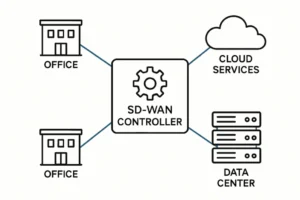Fitness apps aren’t enough anymore.
Users don’t want to see their calorie logs or workouts. They want apps that help them sleep better, eat healthier, manage stress, and build habits that stay. In 2025, the fitness industry is embracing a significant shift – prioritizing AI-powered complete lifestyle coaching platforms over single-purpose apps.
People want apps that can help enhance their lifestyle, designed and integrated to support their whole-person wellness objectives. If you’re also planning to build, scale or invest in a fitness mobile app or maybe partner with a mobile app development company in New York, this article plays your ultimate guidebook.
The Shift Is Already Happening
Fitness apps were doing well back in time. But with the change in consumers’ perspectives, the idea has fully transformed. Trending apps like Oura, WHOOP, and Headspace have taught users that health is about a lot more than just movement, your nutrition, mental health, sleep, recovery and habits equally contribute.
This reflects that a single-purpose workout tracker cannot do the entire job. To stay relevant and useful for your target customers in 2025, the app developers in NYC must integrate fitness apps with –
- Track multiple wellness inputs (not just steps and reps)
- Personalize goals beyond strength or weight loss
- Respond dynamically to user behavior
Sleep Is a Daily Signal, Not a Bonus Insight
Sleep quality plays a crucial role in enhancing both mental and physical health of human beings. It impacts energy, recovery, performance and even decision-making. If you’re aiming to build a fitness app that succeeds, it should:
- Sync with wearables such as Fitbit, Apple Watch, and Oura to keep track of the users’ sleeping patterns, moods, stress-levels, etc.
- Adjust workout suggestions and recommendations on the basis of previous night’s sleeping pattern.
- Push alerts when poor sleep is recorded on a consistent basis and offer in-app solutions.
Nutrition Has Moved Beyond Calorie Counting
Calorie counting and food logging are tedious and old-fashioned. In 2025, users expect fitness apps to offer smart nutrition management solutions that require less effort and offer greater outcomes. You can build features like:
- Food recognition via camera, powered by AI.
- Habit nudges such as, ‘you missed breakfast again, want a quick recipe to go with?’
- Personalized adjustments based on workouts, recovery, or stress-levels, etc.
While calories are important and shall be maintained, it’s the consistency that matters most.
Mental Health Integration Is a Non-Negotiable
People are often unable to work out or exercise because of feeling overwhelmed, stressed or burned out. Mental health is a major component driving physical fitness and that is why your app should integrate features for –
- Emotion tracking and mood check-ins.
- Breathing exercises and guided meditation.
- Program adjustments on the basis of stress-levels.
Fitness apps at hat support emotional resilience keeps the most number of users engaged, especially in the longer run.
Habits Are the Retention Engine
Habits-building is the finest approach for it can not only help users achieve their fitness targets but also keep them retained in the longer run. If you also want users to keep coming back to your fitness app, include –
- Streak systems in combination with coaching paths or rewards.
- Custom habit loops including posture, hydration, and sleep, etc.
- Adaptive reminders on the basis of missed behavioral activity.
The key to success is not only track behavior but also help users build it.
AI-Backed Coaching In Real-Time, No Static Plans
Generic work-out plans are no longer accepted. In 2025, users expect coaching in real-time that can align with their specific goals and objectives. To achieve that, your app should:
- Analyze and keep track of user behavior across wellness dimensions.
- Offer workout recommendations on the basis of sleep, energy levels and goals.
- Interaction via voice or chat such as, not feeling it today, try this instead.
The right integration of AI can turn your app into a live fitness coach instead of a robotic fitness library.
Wearable Sync Is the Standard
The modern consumer ask for convenience, every minute, every second. So, it is important for your fitness app to integrate with the multiple kinds of wearables such as:
- Sleep trackers
- Smart scales
- Heart rate monitors
- Activity bands
Data tracked and gathered from such wearables offer enhanced insights. If your app fails to sync with them all, it’s certainly obsolete and will fade away in the crowd.
Smaller, Private Communities Beat Public Leaderboards
The social motivation is changing. People now prefer collaborating with smaller groups that have common objectives, social status and lifestyles instead of being impressed by public figures and giants. So, the best you can do with your fitness app is not get it endorsed by a popular public figure with millions of following – instead, have micro-influencers on board and let people build a community with them.
The users of today prefer:
- Habit partners for accountability
- Small groups with shared schedules and goals
- Challenge-based groups with real outcomes
Put the global step-count leaderboards aside for a while and focus on the contextual community, there’s certainly more steady growth there.
Voice-First Interaction Is Gaining Ground
With AI at hands, voice-first interaction has become easy to incorporate with effective results. Since users like less hassle and more convenience in the recent times, you can outsmart competitors by adding –
- Verbal check-ins and logs (like, long my water intake or workout, etc.)
- Voice-activated workout control.
- Audio-coaching without having to look at the screen.
In 2025, apps that cut down frictions will win the race.
Subscription Fatigue Is Driving Monetization Innovation
Users are almost overwhelmed and frustrated with the monthly subscription models and that too for the static libraries. A better way to keep them retained is:
- Pay-per-outcome (for example, after completing a program or to unlock a new level, etc.)
- Freemium – habit streak boosts
- Corporate wellness and group subscriptions
The modern consumer will pay for outcomes, not just access.
Why Does Building Live Lifestyle Coaching Apps Matter Now
The average user who’s interested in fitness has seen it all.
They’ve downloaded workout apps that guarantee crazy transformations, tracked their footsteps and calories for weeks, and followed 20-days and 30-days challenges – and then what? Dropped off. Not because they were not disciplined enough, but because those apps were not designed to evolve and adapt with their changing needs.
In 2025, users expect:
- Hyper-personalization – they can instantly know when you’re handing them the cookie-cutter plans and when the plans are being custom-built in alignment with their needs and requirements.
- Want Integration – a major chunk is using wearables such as mental health trackers, smart scales, and productivity tools and they want fitness apps to easily integrate with all of them.
- Prioritize Sustainability – they are more focused about long-term sustainability and achievements instead of hitting a jackpot plan that sets their life straight for like two days, maybe.
So, what does that mean?
If you’re building a fitness app that only covers workouts for users, there’s a high chance your users will bounce back after week 3 at maximum. Contrarily, if your app offers help with better sleep, stress navigation, building healthier habits and adapts to their specific moods and behaviors – you’re offering them a tool they would love to hold on for a longer period.
Building a successful fitness app in today’s world is not just feature stacking, it’s creating data-driven, meaningful coaching experiences that users can stick with.
Final Thoughts
The fitness app of 2025 isn’t just a workout tracker. It’s a lifestyle coach—smart, adaptive, and fully integrated into a user’s daily routine. Users are no longer looking for six-pack shortcuts or 30-day challenges. They want long-term change, built on better sleep, smarter nutrition, mental clarity, and consistent habits.
If you’re building in this space, the opportunity is massive—but only if you’re thinking holistically.
So here’s what you need to do:
- Founders: Reposition your product. Build around real-life behavior, not just performance metrics.
- Investors: Look for wellness platforms with long-term retention and multi-dimensional user value.
- Developers & product teams: Code for adaptability. Sync with wearables, build habit loops, and bake in intelligence.
- Wellness brands: Create ecosystems, not features. Own the daily ritual, not just the workout.
The bottom line?
Stop building fitness apps.
Start building coaching platforms that change lives—one routine at a time.
Also Read-Streamlined Payment Management for Healthcare Practices








